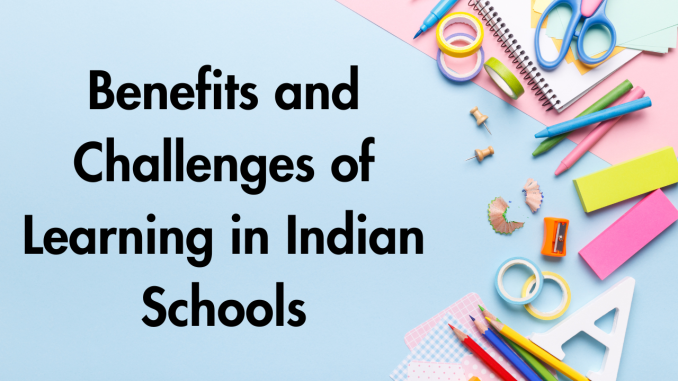
Balanced Benefits and Challenges of Learning in Indian Schools
India’s educational industry is not spared by the rapid development and spread of digital technology in all human activities like other spheres of human life. One emerging trend is blended learning which integrates traditional teaching methods with online learning.
In a K-12 environment where resource limitations and disparities persist, these models open up new possibilities to enhance access to quality education in India. Nevertheless, there are also unique contextual factors that must be considered when implementing them successfully.
In this post, we shall talk about some important positives and negatives attached to blended learning within the Indian school system as well as ways to make use of its influence without falling prey to probable mishaps. In a tech-driven future for Indian education, balancing opportunities and hurdles will be vital.
What is Blended Learning?
Firstly, we need to understand what blended learning means. According to The Christensen Institute blended learning refers to formal education programs that integrate online delivery with supervised brick-and-mortar teaching whereby students have power over particular aspects such as path, time or location.
Rather than simply layering technology atop existing methods, true blended approaches fundamentally rethink instructional models to meaningfully integrate online and offline components. Teachers may deliver foundational content online, freeing up class time for collaborative projects. Or students might learn at varied paces using adaptive software.
Regardless of model, the core aim remains leveraging both digital and human touch points to personalize learning. With that context, let’s turn to key advantages.
Benefits of Blended Learning in India
Increasing Accessibility
India’s vast population and geography create immense pressures to democratize educational opportunity. Blended programs can extend access to quality instruction for students in remote or under-resourced areas.
Online content can be disseminated far beyond what individual teachers could physically reach. And modular digital lessons remove dependencies on local faculty expertise alone. Blended classrooms thus help equalize student support even amidst educator shortages.
Enabling Student-Centered Personalization
One-size-fits-all curricula often leave behind students with diverse needs. Blended models leverage technology to adapt instruction to individual skill levels, languages, and learning styles.
Adaptive software personalizes practice problems to pinpoint knowledge gaps. Multimedia resources present ideas through varied formats to suit visual, auditory, and other learners. Data analytics also help teachers tailor face-to-face guidance.
Such mass customization would be impossible with textbooks alone. Blended approaches meet K-12 students where they are to boost motivation and mastery.
Promoting 21st Century Skills
As workplaces digitize, students need skills like virtual collaboration and independent research to thrive in knowledge economies. Blended classrooms build vital digital literacy by integrating tools professionals use daily.
Since students often lack home internet access, school-based blended programs ensure all kids gain tech proficiencies to avoid future marginalization. Balancing online and social interactions also hones abilities to communicate and problem-solve across modalities.
Preparing students for 21st century success hinges on bridging digital divides early through hands-on exposure in K-12.
Challenges of Blended Learning in India
Technological Infrastructure
While internet connectivity has surged in recent years, India still faces uneven speeds and reliability, especially outside major cities. Inadequate infrastructure hampers rural schools looking to stream video content or run data-intensive platforms.
Even in connected areas, low-income students often lack home devices to complete online assignments or extend classroom learning. Schools adopting blended programs must invest heavily in robust networks, functional labs, and equitable device access policies.
Budgets permitting, mobile-friendly and offline-enabled solutions should be prioritized for maximum reach.
Teacher Training and Support
Many veteran educators feel daunted integrating unfamiliar digital tools into established routines. Without proper training, teachers resort to using technology as glorified textbooks rather than fundamentally rethinking pedagogy.
Schools need professional development to help faculty not only operate platforms, but redesign lessons around active, student-driven learning. Coaching and co-planning time are essential to troubleshoot challenges and adapt approaches across subjects.
Administrators must go beyond one-off workshops to nurture a culture of continuous improvement with blended practices.
Contextual Relevance of Digital Content
Despite explosive edu-tech growth, much available content reflects Western perspectives misaligned with Indian curricula and values. Adapting products to local languages alone doesn’t suffice when core examples or storylines feel culturally foreign.
The dearth of contextual content leaves districts to create bespoke digital libraries in-house or modify imported materials. Increased public-private partnerships could boost open educational resources tailored to India’s multilingual and multicultural K-12 landscape.
Procuring or commissioning diverse and inclusive online instruction remains an vital but neglected step.
The Path Forward
India’s K-12 system sits at a critical juncture for digital transformation through blended learning. When thoughtfully implemented, integrated online and offline instruction can extend educational equity and quality to millions of underserved students.
But to fully realize those benefits, policymakers and practitioners must proactively address challenges around infrastructure, training, and content. Only by coupling tech tools with systemic supports can blended programs sustainably yield better outcomes across India’s diverse contexts.
With student-centric strategies backed by bold investments and political will, India’s schools can balance the barriers and breakthroughs of blended learning to shape an education system worthy of its 21st century ambitions.
Leave a Reply